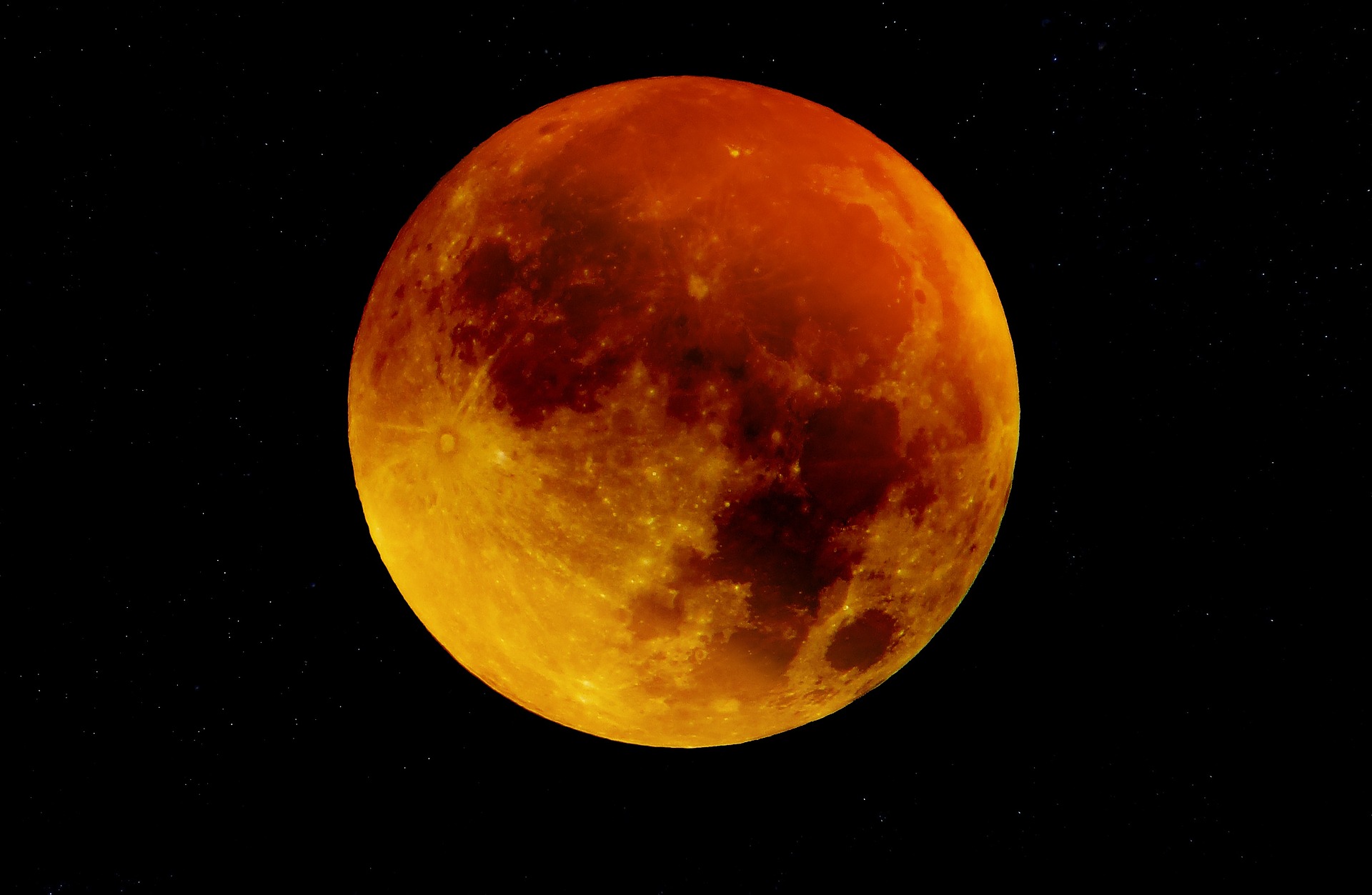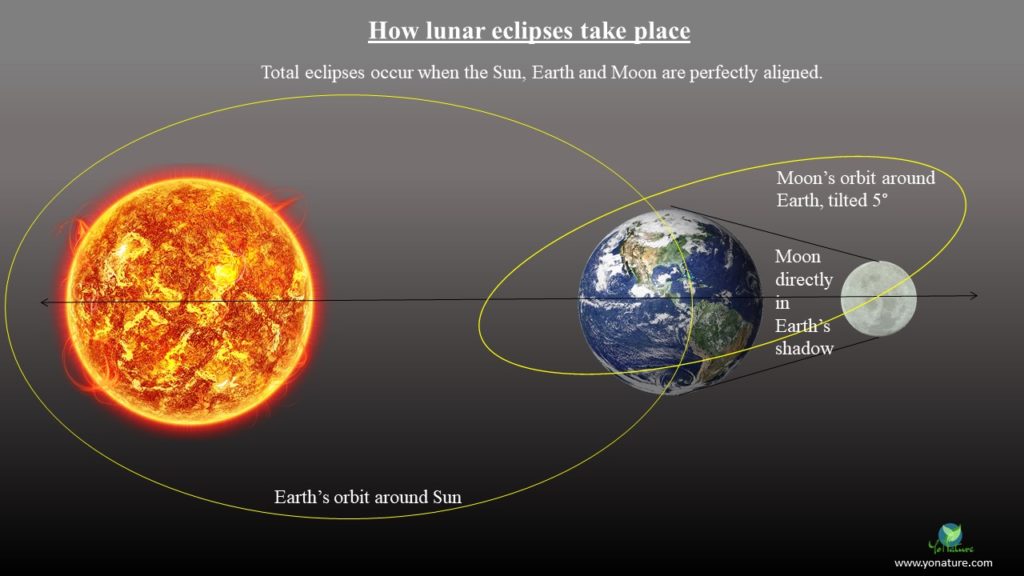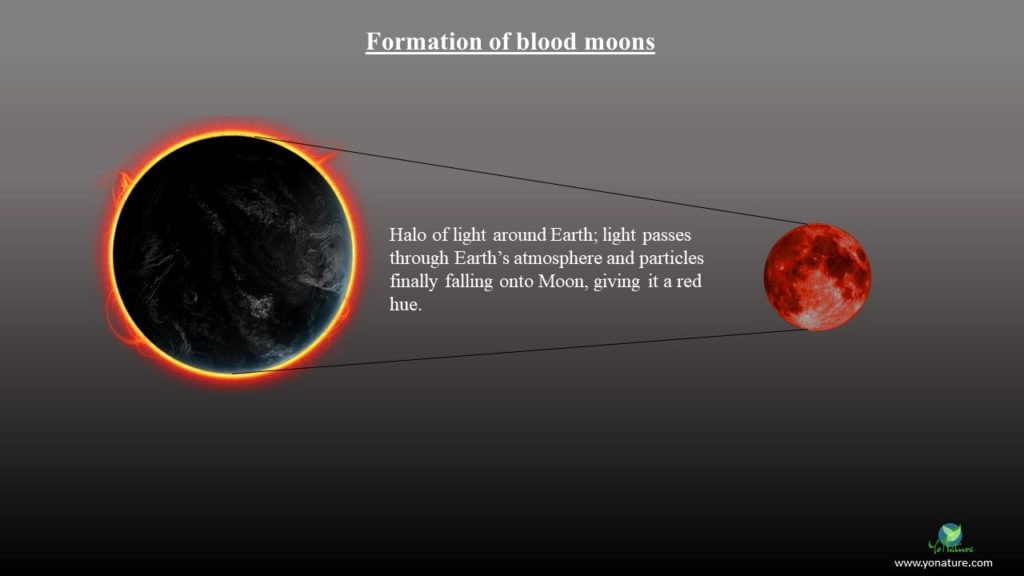Blood Moons Explained – Astronomical and Spiritual Significance

Over the years, the term Blood Moon has taken quite some significance and made its name in history. Besides arousing the fascination of astronomy lovers, this phenomenon sparks the interest of both astrologers and the religious brethren because of what they read into it. While many see the Blood Moon as a bad omen, it remains a spectacular sight.
Blood moon – Astronomical explanation
Lunar eclipses
Eclipse – when the light of a body is hidden because another body is between it and its source of light.
Eclipses occur due to the alignment of the Sun, Earth and Moon. A lunar eclipse occurs when the Earth comes in between the Sun and the Moon. Total eclipses take place when these bodies are perfectly aligned. Earth prevents the Sun’s light from reaching the moon. A maximum of 3 lunar eclipses can occur in any year.
The moon orbits Earth over a period of ≈29 days, (hence marking months on calendars), but it is only during a full moon that an eclipse can take place. So, even though there’s a full moon every month, lunar eclipses are not that frequent because of the slope of the Moon in relation to the Earth. Moon is slanted 5° to Earth’s orbit around the Sun; most of the time, it either passes over or under Earth’s shadow. When the Moon comes directly into Earth’s full shadow while Earth comes directly in front of the Sun, all in perfect alignment, a lunar eclipse takes place.

Blood moon
A blood moon simply refers to the moon with a reddish hue (blood – red color). Astronomers have used the term blood red to refer to the color of the moon during lunar eclipses. To note that the moon does not always appear blood red, but can also take on yellow, brown, orange to red colors (and anything in between them) during these blood moons.
What happens during a lunar eclipse is that Earth comes directly in front of the Sun but it does not cover it completely. There’s still a halo of light around the Earth at that point. A small amount of light still falls onto the Moon. Since Earth is surrounded by an atmosphere with gases and particles, much of the light from the Sun is filtered out and refracted. The shorter light rays like blue are easily scattered while the longer red rays get through. They fall onto the Moon giving it a reddish color. Thus, blood moon.

Sunsets and the beautifully colored sky
The same principle applies to sunsets. The Sun is further from the Earth at this point, so the shorter blue light rays are dispersed while the longer red ones get though. The sky appears yellowish, orange or red depending on the amount of particles in the sky such as dust and flecks of pollution.
Blood moon and biblical prophecies
Joel 2:31 (King James Version) – ‘The sun shall be turned into darkness, and the moon into blood, before the great and terrible day of the Lord come.’
Revelation 6:12 (King James Version) – ‘And I beheld when he had opened the sixth seal, and, lo, there was a great earthquake; and the sun became black as sackcloth of hair, and the moon became as blood;’
Another version of the Bible, the New Living Translation, renders the verse like this:
Joel 2:31 ‘The sun will become dark, and the moon will turn blood red before that great and glorious day of the Lord arrives.’
Pastor John Hagee, author of the book, Four Blood Moons, says he got the term blood moon from the above scripture [1].
Ever since, whenever such eclipses take place, as the moon takes on a reddish color, blood moons come to mind.
God uses signs in the sky to forewarn his plans
In his book, Pastor Hagee explains the significance of lunar tetrads (back in 2014/2015 when it was happening) and its relation to the Church of Jesus Christ and the end times. He emphasized on how God uses signs in the sky to forewarn his plans and what will be happening in the last days as depicted in the book of Revelation.
Though there have been blood moons even before the term was used, the particular one that triggered interest in 2014/15 was due to the fact that they fell on Jewish feasts and Shemitah year (7th sabbatical year) and there was a total solar eclipse as well (Joel 2:31 ‘The sun will become dark, and the moon will turn blood red before that great and glorious day of the Lord arrives.’ Solar eclipse + Blood moon). Jews and Christians interpret these signs in the sky as omens as well as scriptural fulfillment.
Full moon names given by the Native Americans
Even before the blood moon was seen as having prophetic significance, back in the old days, Native Americans nicknamed the different full moons to mark months and seasons.
Interesting to note that in folklore, during the month of October, the full moon, known as Hunter’s moon (because it helps hunters in finding prey) is also called the sanguine or blood moon. Hunter’s moon appears low in the sky during that time as it rises shortly after sunset. Light in Earth’s atmosphere gets scattered by clouds and dust particles giving the moon a red color.
Full moon names and their meanings
- Wolf moon (January) – Wolves scurry outside villages howling hungrily in cold winter.
- Snow moon (February) – Wind brought a huge amount of snow in the north.
- Worm moon (March) – Worms struggle to the earth’s surface depicting the arrival of spring.
- Pink moon (April) – First flowers that sprout, the pink phlox.
- Flower moon (May) – Full spring, flowers bloom everywhere.
- Strawberry moon (June) – Season for the Indians to pick strawberries.
- Thunder moon (July) – The weather changes and thunderstorms become common.
- Sturgeon moon (August) – Named after the sturgeon fish which is common at that time in North American lakes and rivers.
- Harvest moon (September) – Time to harvest yields, the moon appears bright thus helping farmers to work late at night.
- Hunter’s moon (October) – When meat becomes plentiful.
- Beaver moon (November) – Beavers get ready for the coming winter.
- Cold moon (December) – Winter strike and the days become long and hard.
Additional moons
- Blue moon – extra moon – The blue moon refers to an additional full moon that happens because the moon finishes its orbit around the Earth before the Earth finishes its own around the Sun. This rare phenomenon happens once every 2.5 years. This is because the moon finishes its orbit 11 days before the earth every year which adds up to give an extra blue moon.
- Supermoon – The closest that Moon gets to the Earth on its orbit and appears 14% bigger and 30% brighter.
Reference:
Pastor John Hagee on ‘Four Blood Moons’. (2018). Dailymotion. Available at https://www.dailymotion.com/video/x6e154n [Accessed 20th January 2019]

Pingback: 10 reasons Why the sea level is rising - Yo Nature
Pingback: Landslides Explained: Types, Causes and Examples - Yo Nature
Pingback: Climate change: Natural and Anthropogenic causes - Yo Nature